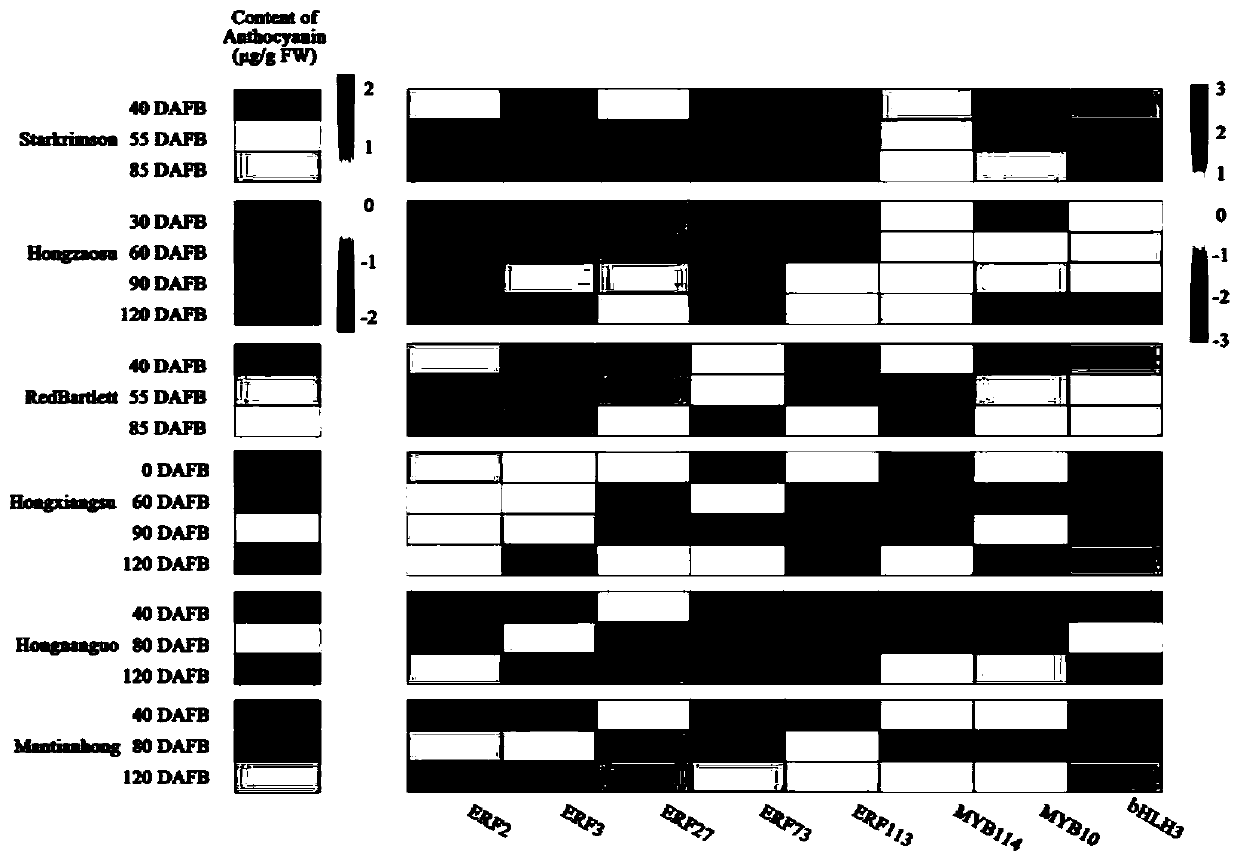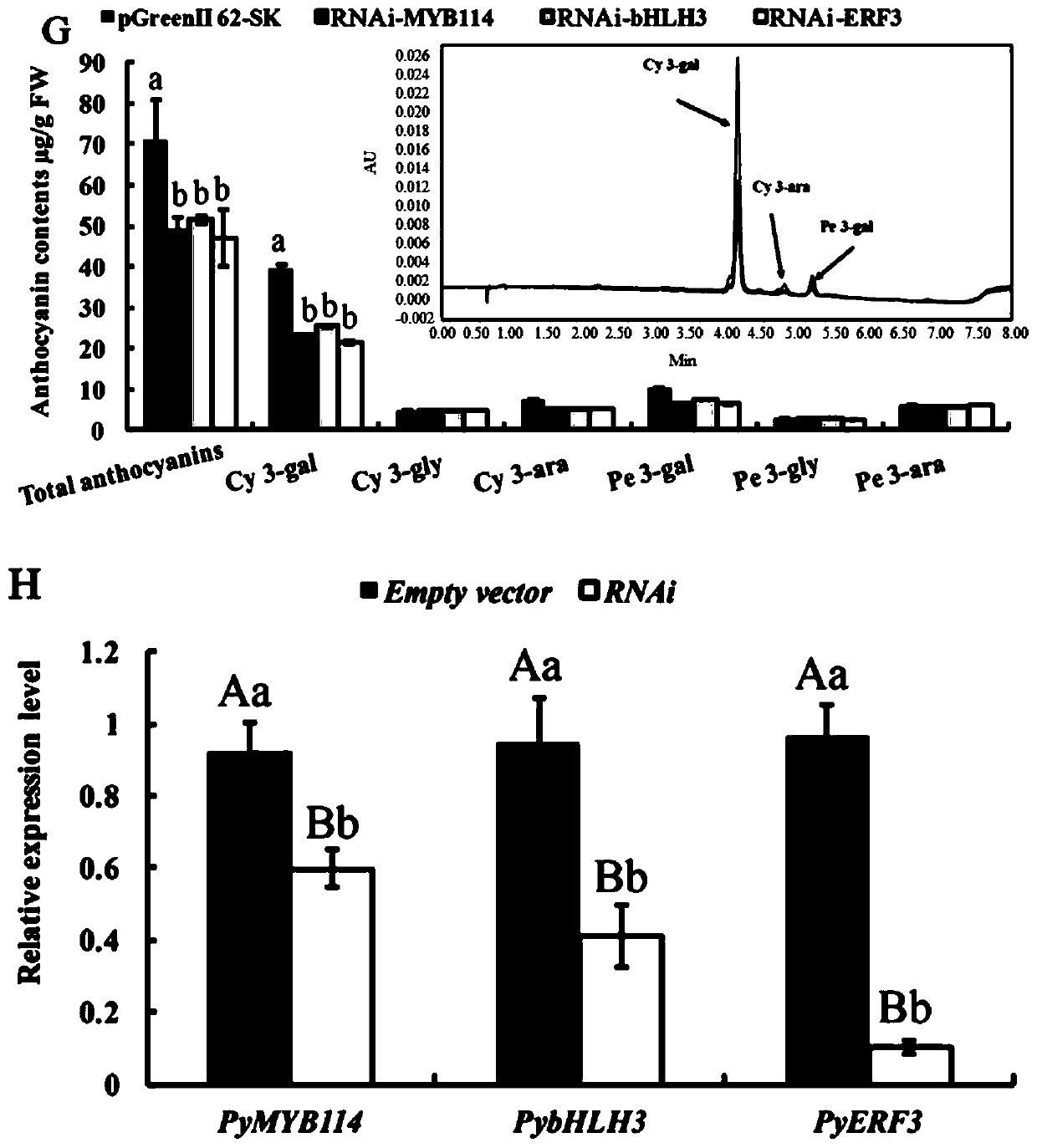Pear transcription factor pyerf3 and its recombinant expression vector and application
A technology of recombinant vectors and expression vectors, which is applied in the field of plant genetic engineering to achieve environmental friendliness and reduce agricultural costs
- Summary
- Abstract
- Description
- Claims
- Application Information
AI Technical Summary
Problems solved by technology
Method used
Image
Examples
Embodiment 1
[0034] Example 1 Expression analysis of the PyERF3 gene of the present invention in red-skinned pear varieties with different coloring patterns
[0035]It has been shown in previous reports that anthocyanin biosynthesis is regulated by the transcriptional regulatory complex. We selected the transcription factors screened in the red / green pericarp RNA-seq data (Yang et al., 2015) and the candidate gene PyMYB114 for correlation analysis. Interestingly, five APETALA2 / ERFs (AP2 / ERFs) transcription factors were found to be up-regulated in the pericarp of Hongpi pear 'Red Eggplant', and showed a consistent expression pattern with PyMYB114. The naming method of the AP2 / ERFs gene is based on the gene with the highest similarity sequence in the comparison results of the NCBI database as the reference. In this study, we selected 6 red-skinned pear varieties at different development stages to verify whether the expression patterns of the candidate gene PyMYB114 were consistent with AP2 / ...
Embodiment 2
[0039] Cloning and recombinant vector construction of embodiment 2 PyERF3 gene of the present invention
[0040] RNA was extracted from the peel of 'Red Eggplant' pear, and the first-strand cDNA obtained by reverse transcription was used to amplify the full-length PyERF3 gene. For RNA extraction, Plant Total RNA Isolation Kit Plus (Foregene, RE-05022) was used, and the operation instructions provided by the kit were followed. First-strand cDNA was synthesized using First Script Strand cDNA SynthesisSuperMix (Transgene, AE301-02) reverse transcription kit (operated according to the instructions provided by the kit). Amplified gene primer pair is PyERF3-F1: 5'-ACTAGTGGATCCAAA gaattc ATGTTTTTGGGGTACAGTCGGG-3' (SEQ ID No. 3); PyERF3-R1:
[0041] 5’-CAGGACTCTAGAAGTACT ctcgag TCAACTGGATGAGGATGGATTGTTGC-3' (SEQ ID No. 4). Ultra-Fidelity DNA Polymerase Super-Fidelity DNA Polymerase (P505-d1) was purchased from Novozyme Biotechnology Company. The amplification reaction system ...
Embodiment 3
[0044] Example 3 The co-transformation of the PyERF3 gene of the present invention with other co-acting factors PyMYB114 and PybHLH3 leads to the synthesis of tobacco anthocyanins
[0045]The constructed recombinant vector was used to transiently transform tobacco leaves mediated by Agrobacterium. The results showed that the accumulation of anthocyanin content could not be observed by transforming one transcription factor alone, but the accumulation of a small amount of anthocyanin in tobacco leaves could be observed by transforming two transcription factors PyMYB114 and PybHLH3 together. However, co-transformation of PyERF3 with three transcription factors, PyMYB114 and PybHLH3 3, can accelerate anthocyanin biosynthesis, showing deeper color and stronger response ( figure 2 A). In addition, co-transformation of PyMYB114 and PyMYB10 also resulted in weak pigmentation. Tobacco leaves with anthocyanin accumulation were tested for pigment content by colorimeter and spectrophot...
PUM
| Property | Measurement | Unit |
|---|---|---|
| molecular weight | aaaaa | aaaaa |
Abstract
Description
Claims
Application Information
 Login to View More
Login to View More - R&D
- Intellectual Property
- Life Sciences
- Materials
- Tech Scout
- Unparalleled Data Quality
- Higher Quality Content
- 60% Fewer Hallucinations
Browse by: Latest US Patents, China's latest patents, Technical Efficacy Thesaurus, Application Domain, Technology Topic, Popular Technical Reports.
© 2025 PatSnap. All rights reserved.Legal|Privacy policy|Modern Slavery Act Transparency Statement|Sitemap|About US| Contact US: help@patsnap.com



